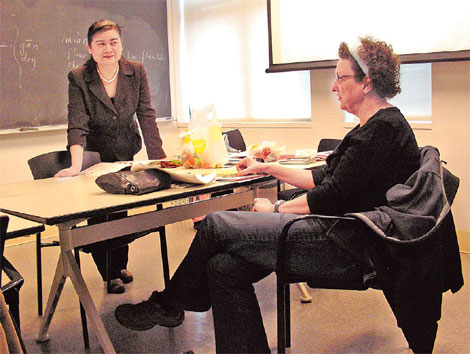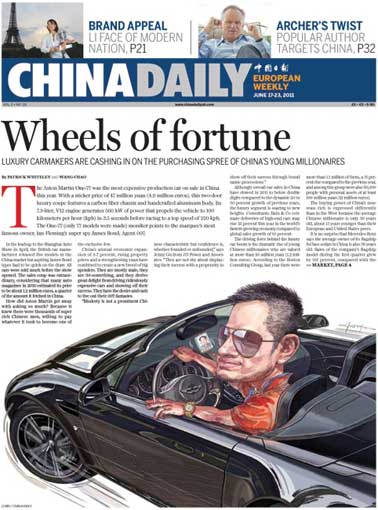Society
Ni hao in New York
Updated: 2011-06-21 07:59
By Diane Nottle (China Daily)
|
Deng Yan, an instructor for New School University's On the Go series of intensive weekend courses, in discussion with one of her students Diane Mitchells. Diane Nottle / For China Daily |
A year after teaching English at a Hunan university Diane Nottle resumes her Chinese lessons in the United States and gets a taste of what her students might have gone through.
"Ni hao! Ni hao ma?" the teacher greeted me warmly as I entered the classroom. "Wo . . . hen . . . hao," I answered. So far, so good. Then she let loose a torrent of sounds that, though incomprehensible, seemed vaguely familiar. This time last year, I was teaching oral English at Hunan University of Science and Technology in Xiangtan. It was almost too easy to live there in my own language, given the eagerness of the students and other Chinese I met to practice their English, but some of the nine foreign teachers (on a campus of 39,000 students) took weekly classes together in Mandarin.
In July, I returned to New York, settled back into my life and barely gave Mandarin another thought. Then the e-mail festooned with bright yellow lanterns popped into my inbox: "Speak Chinese in One Weekend!" It was advertising one of New York-based New School University's On the Go series of intensive weekend courses, offered periodically in languages including French, German, Spanish, Italian, Portuguese, Japanese and Arabic. I studied Japanese at the New School for a year in the 1990s (and, full disclosure, later earned my English language teaching certificate there).
The Chinese weekend intrigued me as a way to test what I had retained, a year later.
There are any number of ways to study Chinese in New York: university courses, language schools like Berlitz, continuing education classes like the New School's, and private tutors. Before leaving for Hunan, I had learned some basics using Rosetta Stone, the interactive language software.
On the Go weekends offer 14 hours of instruction in less than 48 hours: three and a half each on Friday evening and Sunday morning, and seven on Saturday. Since Level 1 is meant for what language teachers call "true beginners" - people with no previous exposure - I gamely signed up for Level 2, which proved challenging. In the end, what resonated most about the weekend was not so much the language I could reproduce, but the insights it provided into Chinese culture and the memories it brought back.
The instructor, Deng Yan, English name Judy, is a Tianjin native who went to university in Beijing. Now 51, she has been living in the United States for 16 years; she also teaches at United Nations headquarters and the China Institute in New York. Deng's method was essentially the same as our teacher's in Xiangtan: She handed out the curriculum - 12 pages of basic phrases and vocabulary she had prepared - and worked her way through them as we repeated after her, asked questions and took notes.
As I looked through the sheets, I began to laugh. They covered practical phrases for activities such as traveling, dining in restaurants and shopping - the very lessons I had taught, only in reverse. Diu le (lost, missing) harked back to my lesson on describing objects, a great help at a lost-and-found counter. And when Deng urged, "Make it sound more spontaneous!" I could hear myself.
Gradually the words came back, and I successfully answered simple questions with phrases like wo jiao ("I am"), wo shi meiguo ren ("I am American"), wo shi yingyu laoshi ("I am an English teacher"). Deng reviewed the four tones that are all-important in Chinese, and so difficult for Westerners. As exercises, she gave us tongue-twisters like gege he kele ("My brother drinks soda") and sishi shi sishi ("44 is 44"), which I spoke very slowly indeed.
After each unit, she tested us by projecting the English phrases on a screen with, sometimes, comical illustrations. She led us through the word order using a red laser pointer and, like the audience at an old-time movie-theater sing-along, we followed the bouncing ball.
I heard phrases I hadn't thought about in nearly a year - mei you ("don't have"), for instance, or deng yixia ("wait a moment"), which I had shouted frequently to stop the campus shuttle bus. In the shopping section, the question, "neng da zhe ma?", reminded me how my students in the corresponding lesson all practiced, "Can I get a discount?" and led me to conclude that the Chinese are very savvy shoppers. Wode dianshi huai le - "My TV is broken" - recalled my campus apartment, where not only the TV but also the doorbell, the refrigerator and the computer were all, at various times, huai le.
As fatigue set in on Friday evening, discussion began to move away from language and into Chinese culture. We noted regional variations - for example, the way the word for the English language is pronounced yingyu in northern China and more like ingyu in Hunan. Giving us the words for geographical directions, Deng explained the order of calligraphy strokes - horizontal first, then vertical.
She also told us the stories behind some characters: that combining the radicals for grass and happy gives you "medicine", made from herbs; that "woman in home" means "safe" and "fire" plus "home" adds up to "disaster"; that "one people with weapons inside a border means country". In other words, one student piped up, "Homeland Security!"
"If you know the meanings of the words, you can learn phrases fast," Deng said. Since ji means machine, for example, feiji - flying machine - is the word for airplane. A tomato can be a fanqie (foreign eggplant, because they're both soft) or a xihongshi (Western red persimmon).
Talking about bread, she explained the difference between the word for counting slices (pian) and the one for a hunk or loaf - kuai, from ingot. Which also helps explain how kuai became an informal synonym for yuan, like "bucks" for "dollars".
Since all the others in the class of five had taken Level 1 with Deng, they seemed li (as in "distance") ahead of me. Yet I knew things they didn't - specifically about food, on which we spent most of Saturday. The words acted on me like Marcel Proust's madeleine (involuntary memory): baozi, the steamed buns I had so enjoyed for breakfast in Xiangtan, which I now learned how to order stuffed with pork, vegetables or red bean paste instead of taking my chances. Chao mian, or fried noodles, and I could now ask for them with jirou instead of just pointing to the chicken. Niurou chao fan, so I would no longer have to order beef fried rice by showing the characters a student had written in my notebook. Jiaozi, the dumplings I would buy from a vendor for a quick dinner as I walked to Chinese class. Caomei zhi, the strawberry juice that restored me to health after a bad dose of McDonald's. Canting, the university canteens where I sometimes had lunch with students. Our teacher in Xiangtan spent a lot of time on fruits, so although there was nothing so exotic as liulian (durian) or shanzhu (mangosteen) in New York, I sailed through the xigua (watermelon), ningmeng (lemon) and pingguo (apple).
On Sunday morning, I arrived with a big fruit salad from the deli downstairs and was pleased to find I could name all its ingredients except honeydew and kiwi. Three hours later, the class had worked its way through the 12 pages, now covered with notes. By now I was far beyond lei (tired); I was exhausted. When Deng suggested using our last 20 minutes to tackle dates, days and time, I nearly burst into tears.

A week later, I feel I'm still learning more about Chinese than actually learning Chinese, but I appreciate what progress I've made. Pinyin still confuses me - for example, remembering that bian is pronounced like bien in French, not "be on", and fen like fun. My pronunciation of riben (Japan) remains laughable; my best effort came out as "urban". I speak the tones better but still have trouble hearing the differences. "That's because they're difficult," another student said. (Aha! That's what I needed to know!) And I still have trouble getting a sentence of more than four syllables out of my mouth, what with remembering the words, getting the consonant sounds right and factoring in the tones.
In short, I still feel as inadequate as I did in class in Xiangtan. But that's all to the good, since it keeps me in touch with how my own students must feel as they struggle with English.
According to Deng, the Chinese language has 50,000 characters, 214 radicals and 432 pronunciations. That's probably more than a mere waiguoren - foreigner - can expect to master in a lifetime, never mind a weekend. But at least one phrase from the curriculum seems worth remembering: Wo xiwang keyi zai lai zhongguo. I hope I can visit China again.
E-paper

Pret-a-design
China is taking bigger strides to become a force in fashion.
Lasting Spirit
Running with the Beijingers
A twist in the tale
Specials

My China story
Foreign readers are invited to share your China stories.

Mom’s the word
Italian expat struggles with learning English and experiences the joys of motherhood again.

Lenovo's challenge
Computer maker takes on iconic brand apple with range of stylish, popular products

